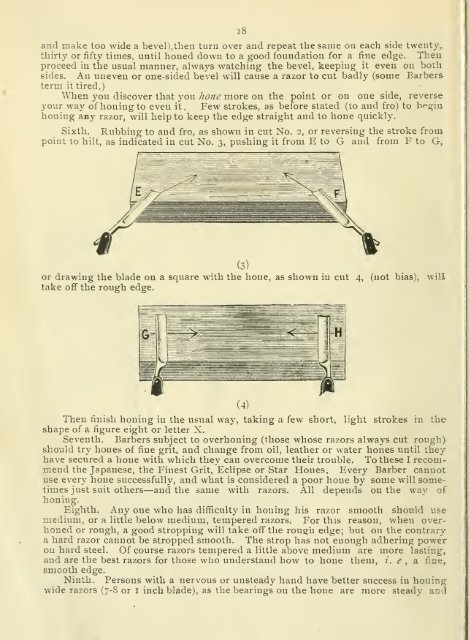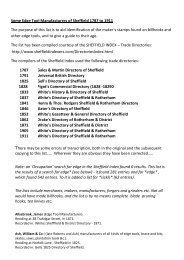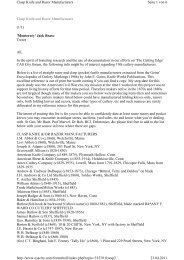razors, razor hones, razor strops and razor honing - antike ...
razors, razor hones, razor strops and razor honing - antike ...
razors, razor hones, razor strops and razor honing - antike ...
You also want an ePaper? Increase the reach of your titles
YUMPU automatically turns print PDFs into web optimized ePapers that Google loves.
i8<br />
<strong>and</strong> make too wide a bevel), then turn over <strong>and</strong> repeat the same on each side twenty,,<br />
thirty or fifty times, until honed down to a good foundation for a fine edge. Then<br />
proceed in the usual manner, always watching the bevel, keeping it even on both<br />
sides. An uneven or one-sided bevel will cause a <strong>razor</strong> to cut badly (some Barbersterm<br />
it tired.)<br />
When you discover that you hone more on the point or on one side, reverse<br />
your way of <strong>honing</strong> to even it. Few strokes, as before stated (to <strong>and</strong> fro) to begin<br />
<strong>honing</strong> any <strong>razor</strong>, will help to keep the edge straight <strong>and</strong> to hone quickly.<br />
Sixth. Rubbing to <strong>and</strong> fro, as shown in cut No. 2, or reversing the stroke from<br />
point to hilt, as indicated in cut No. 3, pushing it from E to G <strong>and</strong> from F to G r<br />
or drawing the blade on a square with the hone, as shown in cut 4, (not bias), will<br />
take off the rough edge.<br />
Then finish <strong>honing</strong> in the usual way, taking a few short, light strokes in the<br />
shape of a figure eight or letter X.<br />
Seventh. Barbers subject to over<strong>honing</strong> (those whose <strong><strong>razor</strong>s</strong> always cut rough)<br />
should try <strong>hones</strong> of fine grit, <strong>and</strong> change from oil, leather or water <strong>hones</strong> until they<br />
have secured a hone with which they can overcome their trouble. To these I recommend<br />
the Japanese, the Finest Grit, Eclipse or Star Hones. Every Barber cannot<br />
use every hone successfully, <strong>and</strong> what is considered a poor hone by some will sometimes<br />
just suit others—<strong>and</strong> the same with <strong><strong>razor</strong>s</strong>. All depends on the way of<br />
<strong>honing</strong>.<br />
Eighth. Any one who has difficulty in <strong>honing</strong> his <strong>razor</strong> smooth should use<br />
medium, or a little below medium, tempered <strong><strong>razor</strong>s</strong>. For this reason, when overhoned<br />
or rough, a good stropping will take off the rough edge; but on the contrary<br />
a hard <strong>razor</strong> cannot be stropped smooth. The strop has not enough adhering power<br />
on hard steel. Of course <strong><strong>razor</strong>s</strong> tempered a little above medium are more lasting,<br />
<strong>and</strong> are the best <strong><strong>razor</strong>s</strong> for those who underst<strong>and</strong> bow to hone them, i. e , a fine,<br />
smooth edge.<br />
Ninth. Persons with a nervous or unsteady h<strong>and</strong> have better success in <strong>honing</strong><br />
wide <strong><strong>razor</strong>s</strong> (7-8 or I inch blade), as the bearings on the hone are more steady <strong>and</strong>






